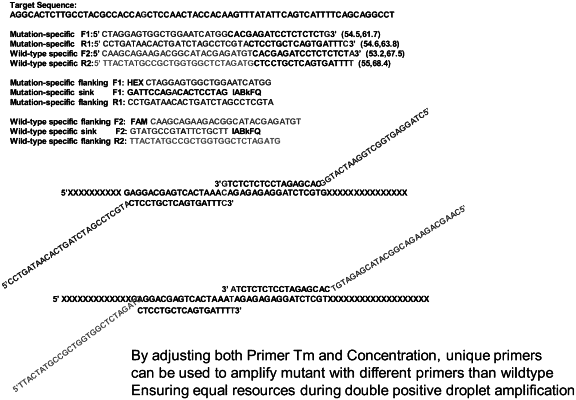| CPC C12Q 1/6865 (2013.01) [C12Q 1/6816 (2013.01); C12Q 1/6827 (2013.01); C12Q 1/6848 (2013.01); C12Q 1/6851 (2013.01); C12Q 1/6853 (2013.01); C12Q 1/6858 (2013.01)] | 9 Claims |

|
1. A plurality of mixture partitions, the individual mixture partitions comprising:
i) a mutation-specific 5′-tailed primer pair, wherein the mutation-specific 5′-tailed primer pair hybridizes to and specifically amplifies target DNA template molecules from a nucleic acid sample that comprise a mutant target sequence, if present, wherein the primers of the mutation-specific 5′-tailed primer pair comprise:
a) a 3′ hybridization region that specifically hybridizes to the mutant target sequence; and
b) a mutation-specific 5′ tail region that does not hybridize to any nucleic acid fragments in the nucleic acid sample;
ii) a wild-type-specific 5′-tailed primer pair, wherein the wild-type-specific 5′-tailed primer pair hybridizes to and specifically amplifies target DNA template molecules comprising a wild-type target sequence, if present, wherein the primers of the wild-type-specific 5′-tailed primer pair comprise:
a) a 3′ hybridization region that specifically hybridizes to the wild-type target sequence; and
b) a wild-type-specific 5′ tail region that does not hybridize to any nucleic acid fragments in the nucleic acid sample, wherein the wild-type-specific 5′ tail region is a different sequence than the mutation-specific 5′ tail region; and
iii) a mutation-specific flanking primer pair, wherein the mutation-specific flanking primer pair hybridizes to and specifically amplifies amplicons comprising the 5′ tail regions of the mutation-specific 5′-tailed primer pair, if present;
iv) a wild-type-specific flanking primer pair, wherein the wild-type-specific flanking primer pair hybridizes to and specifically amplifies amplicons comprising the 5′ tail regions of the wild-type-specific 5′-tailed primer pair, if present; and
v) a thermostable polymerase, wherein
at least some of the mixture partitions of the plurality of mixture partitions contain a target DNA template molecule that comprises a wild-type or mutant target sequence; and
at least some of the mixture partitions of the plurality of mixture partitions do not contain the target DNA template molecule.
|